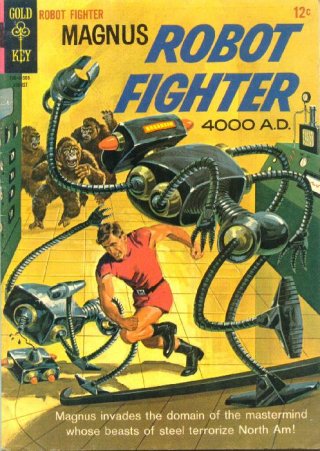All you really to know about Magnus is that he will
live in 4,000 AD, robots will have taken over, and he
is the kind of guy who holds a grudge and wears a mini-dress.
Not sure what's up with the apes.
Magnus really wasn't that complicated - he just really liked killing robots, if killing is the right term (more on that later). In that, he embodied the last vestiges of the deep animosity and suspicion of machines that characterized much of the general reaction to the industrialization that formed life and culture in much of the 19th and early 20th centuries. As these machines replaced humans as the primary source of labor, there was growing speculation among thinkers and writers that someday these mechanisms could be designed to think independently in some fashion - perhaps too independently. Additionally, what if these free thinking machines cast off their chains, so to speak, and began moving about independently as well? The answer, as our friend Magnus knew well, is Robots!
Now, there are many forms of robots. In fact, this guy is running around my pool right now sucking up dirt so I don't have to (I should probably rewrite that last sentence):
Sort of a very damp R2-D2
Like our ancestors of the Industrial Revolution, we find there is something disturbing about a mechanism seeming to operate on its own - the above pool cleaner looks benign, but it still creeps me out when it bumps my leg when I'm in the pool.
What really seems to stir up emotions are the robots that look humanoid-like: Intentionally designed with some form of a head, torso, arms and legs. Czech writer Karel Capek gave us the term "robot" in his 1920 play R.U.R. The term was immediately adopted and used a repository for all our dreams and nightmares regarding technology:
Poor Maria (from Fritz Lang's silent classic Metropolis):
or this:
This type of revulsion at the "other" is what Sigmund Freud called "The Uncanny", a situation where something seems familiar but there is something not quite right. In the article Freud mentions the need for audience members of the opera Tales of Hoffman to grapple with whether or not a doll character is living or some form of automation. Writer Dave Bryant recounts Japanese robotocist Dr. Masahiro Mori term for this uneasiness (which the scientist actually plots): The Uncanny Valley:
This chasm—the uncanny valley of Doctor Mori’s thesis—represents the point at which a person observing the creature or object in question sees something that is nearly human, but just enough off-kilter to seem eerie or disquieting.The "Uncanny Valley" effect isn't just an artifact of robots and opera; As the New York Times reported on November 10, 2004, film directors working with the first forms of computer-generated images (CGI) found that while audiences embraced anthropomorphic fish and other animals, they had issues with more human images:
The largest intractable problem with "The Polar Express" is that the motion-capture technology used to create the human figures has resulted in a film filled with creepily unlifelike beings... With their denatured physiognomy, the human characters in "Polar Express" don't just look less alive than Gollum; they look less alive than the cartoon family in Brad Bird's "Incredibles." It's baffling that Mr. (director Robert) Zemeckis, who can make the screen churn with life, didn't see how dead these animated characters look. (The New York Times)So, in a strange sort of irony, the more human-like a robot becomes, the more we fear and loathe it, unless it becomes and remains truly undetectable from actual humans:
Tomorrow - Robots get a makeover, and an un-makeover, at the same time... Man and Machine Part 3 - More Robots!


No comments:
Post a Comment